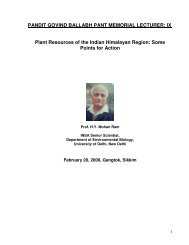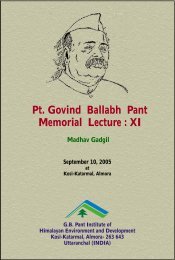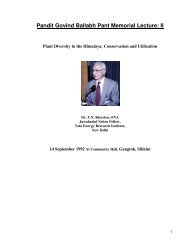PANDIT GOVIND BALLABH PANT MEMORIAL LECTURE: VII ...
PANDIT GOVIND BALLABH PANT MEMORIAL LECTURE: VII ...
PANDIT GOVIND BALLABH PANT MEMORIAL LECTURE: VII ...
You also want an ePaper? Increase the reach of your titles
YUMPU automatically turns print PDFs into web optimized ePapers that Google loves.
mm/yr in the extreme northwestern Himalaya (Burbank et al., 1996), 5mm/yr in<br />
southwestern Garhwal (Rajal etal.,1986), and 2 to 3 mm/yr in southecentral Nepal<br />
(Jackson and Bilham, 1984), the uplift of terrain has prompted quickening of erosion<br />
rate it is 0.13 mm/yr in dry season to 0/91 to 3.38 mm/yr during rains in central<br />
Kumaun (Rawat and Rawat, 1994), 1.73 mm/yr in southcentral Kumaun (Bartarya and<br />
Valdiya, 1989), and 1.38 mm/yr in eastern Nepal (Carson, 1985). The present rate of<br />
erosion is many times higher than what is was in the immediate geological past.<br />
One of the consequences of accelerated pace of erosion is the voluminous production<br />
of sediment, which fills valleys reservoirs. Every one hundred square kilometer area of<br />
the catchment of the Bhagirathi upstream of the Tehri dam, for example, is producing<br />
22.72 ha-m of sediments annually (Bhumbla et al., 1990). If the bed load-which is<br />
normally taken at 15% of the suspended load-is also taken into account, the amount of<br />
accumulated sediments would be quite large. Interestingly, in some rivers in westerncentral<br />
Nepal the bed-load can be 500% to 1000% of the suspended load (Carson,<br />
1985). One can judge the magnitude of erosion and the volume of debris accumulating<br />
in reservoirs and floodplains. Along with sediments goes down the nutrient-rich soil,<br />
the building block of life. Even slight tampering such as modification of topography for<br />
road construction or mining can aggravate soil loss and attendant hazards or land<br />
degradation.<br />
Coping With Hazards of Mass-movement<br />
People suffer from the natural hazard not because it happens, but because they come<br />
in the way of the natural events occurring swiftly or suddenly (Valdiya, 1987). Of<br />
course, man’s own activities hasten the natural processes. The programme of coping<br />
with the landslide hazard requires identification of areas/belts prone to rock falls,<br />
landslides and debris flows (Figure 5) on the basis of geological and geomorphological<br />
features, rainfall data, history of past occurrence, and present sings of slope instability.<br />
It should be abundantly clear that for the environmental security of an area. The<br />
preparation of landslide hazard zoning map is an item of high priority. This requires<br />
combined efforts of geologists and geomorphologists.<br />
Figure 5. Identifying zones or areas of slope instability and proness to landslides is an<br />
essential prerequisite in the exercise of hazard management.Mehrotra (1994)<br />
attempts at hazard-zoning in the Bhagirathi valley in which the Tehri Dam is<br />
located.<br />
2. Water Conservation and Spring Sanctuaries<br />
Too Little-Too Much-Water Syndrome<br />
More than a billion people living in Tibet, Pakistan, India and Bangaldesh depend<br />
on the water of the Himalayan rivers. Despite abundance of flow (12,00.000 million<br />
m 3 /year) ------ 4,60,000 million m 3 of the Ganga alone (Table 1) ----- there is scarcity of<br />
7











